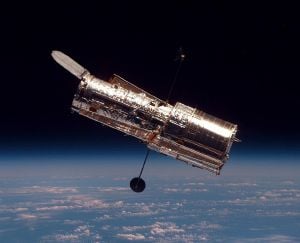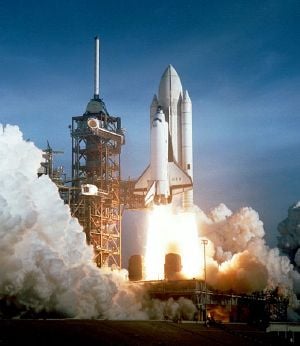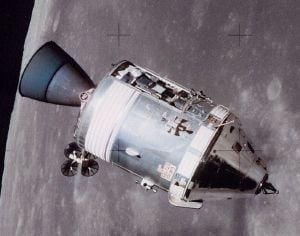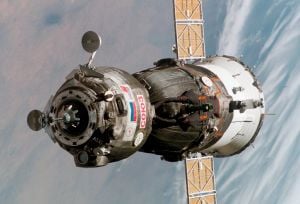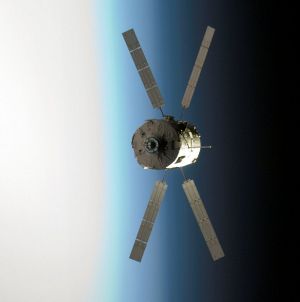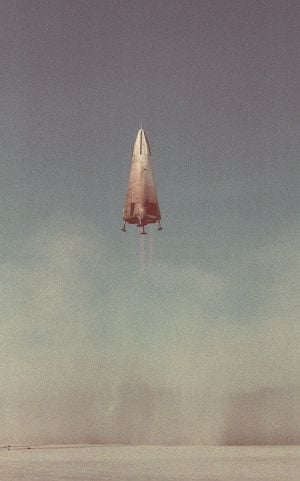Spacecraft
A spacecraft is a craft or machine designed for spaceflight. Although it is, by definition, designed to travel into space, it may or may not be intended to return to the Earth.
Spacecraft are used for a variety of purposes, including communications, earth observation, meteorology, navigation, planetary exploration and space tourism. Spacecraft used for human spaceflights carry people on board as crew or passengers. Spacecraft used for robotic space missions operate either autonomously or telerobotically. Robotic spacecraft that leave the vicinity of the planetary body are called space probes. Robotic spacecraft that remain in orbit around the planetary body are artificial satellites. Starships, conceived for interstellar travel, are still in the realm of theoretical ideas. Spacecraft and extremes of space travel are common themes in works of science fiction.
Spacecraft subsystems
A spacecraft includes a variety of subsystems, dependent upon mission profile. These subsystems may include: attitude determination and control (variously called ADAC, ADC or ACS); guidance, navigation and control (GNC or GN&C); communications (COMS); command and data handling (CDH or C&DH); power (EPS); thermal control (TCS); propulsion; structures; and payload.
- Life support
- Spacecraft intended for human spaceflight must also include a life support system for the crew. This can include many different types of Oxygen Systems, such as the one seen in the movie Apollo 13 (1995) that exploded and almost cost the crew their lives.
- Attitude control
- Spacecraft need an attitude control subsystem to be correctly oriented in space and respond to external torques and forces properly. The attitude control subsystem consists of sensors and actuators, together with controlling algorithms. The attitude control subsystem permits proper pointing for the science objective, Sun-pointing for power to the solar arrays and Earth-pointing for communications.
- GNC
- (Guidance Navagation and Controls) Guidance refers to the calculation of the commands (usually done by the CDH subsystem) (Command & Data Handling) needed to steer the spacecraft where it is desired to be. Navigation means determining a spacecraft's orbital elements or position. Control means adjusting the path of the spacecraft to meet mission requirements. On some missions, GNC and Attitude Control are combined into one subsystem of the spacecraft.
- Command and data handling
- The CDH subsystem receives commands from the communications subsystem, performs validation and decoding of the commands, and distributes the commands to the appropriate spacecraft subsystems and components. The CDH also receives housekeeping data and science data from the other spacecraft subsystems and components, and packages the data for storage on a solid state recorder or transmission to the ground via the communications subsystem. Other functions of the CDH include maintaining the spacecraft clock and state-of-health monitoring.
- Power
- Spacecraft need an electrical power generation and distribution subsystem for powering the various spacecraft subsystems. For spacecraft near the Sun, solar panels are frequently used to generate electrical power. Spacecraft designed to operate in more distant locations, for example Jupiter, might employ a Radioisotope Thermoelectric Generator (RTG) to generate electrical power. Electrical power is sent through power conditioning equipment before it passes through a power distribution unit over an electrical bus to other spacecraft components. Batteries are typically connected to the bus via a battery charge regulator, and the batteries are used to provide electrical power during periods when primary power is not available, for example when a Low Earth Orbit (LEO) spacecraft is eclipsed by the Earth.
- Thermal control
- Spacecraft must be engineered to withstand transit through the Earth's atmosphere and the space environment. They must operate in a vacuum with temperatures potentially ranging across hundreds of degrees Celsius as well as (if subject to reentry) in the presence of plasmas. Material requirements are such that either high melting temperature, low density materials such as Be and C-C or (possibly due to the lower thickness requirements despite its high density) W or ablative C-C composites are used. Depending on mission profile, spacecraft may also need to operate on the surface of another planetary body. The thermal control subsystem can be passive, dependent on the selection of materials with specific radiative properties. Active thermal control makes use of electrical heaters and certain actuators such as louvers to control temperature ranges of equipments within specific ranges.
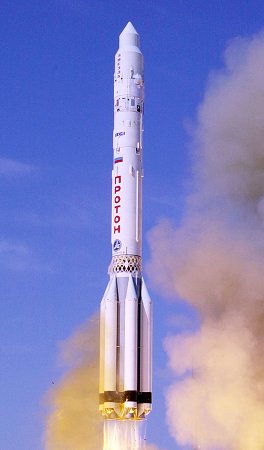
- Propulsion
- Spacecraft may or may not have a propulsion subsystem, depending upon whether or not the mission profile calls for propulsion. The Swift spacecraft is an example of a spacecraft that does not have a propulsion subsystem. Typically though, LEO spacecraft (for example Terra (EOS AM-1) include a propulsion subsystem for altitude adjustments (called drag make-up maneuvers) and inclination adjustment maneuvers. A propulsion system is also needed for spacecraft that perform momentum management maneuvers. Components of a conventional propulsion subsystem include fuel, tankage, valves, pipes, and thrusters. The TCS interfaces with the propulsion subsystem by monitoring the temperature of those components, and by preheating tanks and thrusters in preparation for a spacecraft maneuver.
- Structures
- Spacecraft must be engineered to withstand launch loads imparted by the launch vehicle, and must have a point of attachment for all the other subsystems. Depending upon mission profile, the structural subsystem might need to withstand loads imparted by entry into the atmosphere of another planetary body, and landing on the surface of another planetary body.
- Payload
- The payload is dependent upon the mission of the spacecraft, and is typically regarded as the part of the spacecraft "that pays the bills." Typical payloads could include scientific instruments (cameras, telescopes, or particle detectors, for example), cargo, or a human crew.
- Ground segment
- The ground segment, though not technically part of the spacecraft, is vital to the operation of the spacecraft. Typical components of a ground segment in use during normal operations include a mission operations facility where the flight operations team conducts the operations of the spacecraft, a data processing and storage facility, ground stations to radiate signals to and receive signals from the spacecraft, and a voice and data communications network to connect all mission elements.[1]
- Launch vehicle
- The launch vehicle is used to propel the spacecraft from the Earth's surface, through the atmosphere, and into an orbit, the exact orbit being dependent upon mission configuration. The launch vehicle may be expendable or reusable.
Reusable spacecraft
The first reusable spacecraft, the X-15, was air-launched on a suborbital trajectory on July 19, 1963. The first partially reusable orbital spacecraft, the Space Shuttle, was launched by the USA on the 20th anniversary of Yuri Gagarin's flight, on April 12, 1981. During the Shuttle era, six orbiters were built, all of which have flown in the atmosphere and five of which have flown in space. The Enterprise was used only for approach and landing tests, launching from the back of a Boeing 747 and gliding to deadstick landings at Edwards AFB, California. The first Space Shuttle to fly into space was the Columbia, followed by the Challenger, Discovery, Atlantis, and Endeavour. The Endeavour was built to replace the Challenger when it was lost in January 1986. The Columbia broke up during reentry in February 2003.
The first automatic partially reusable spacecraft was the Buran (Snowstorm), launched by the USSR on November 15, 1988, although it made only one flight. This spaceplane was designed for a crew and strongly resembled the U.S. Space Shuttle, although its drop-off boosters used liquid propellants and its main engines were located at the base of what would be the external tank in the American Shuttle. Lack of funding, complicated by the dissolution of the USSR, prevented any further flights of Buran. The Space Shuttle has since been modified to allow for autonomous re-entry via the addition of a control cable running from the control cabin to the mid-deck which would allow for the automated deployment of the landing gear in the event an un-crewed re-entry was required following abandonment due to damage at the ISS.
Per the Vision for Space Exploration, the Space Shuttle is due to be retired in 2010 due mainly to its old age and high cost of program reaching over a billion dollars per flight. The Shuttle's human transport role is to be replaced by the partially reusable Crew Exploration Vehicle (CEV) no later than 2014. The Shuttle's heavy cargo transport role is to be replaced by expendable rockets such as the Evolved Expendable Launch Vehicle (EELV) or a Shuttle Derived Launch Vehicle.
Scaled Composites' SpaceShipOne was a reusable suborbital spaceplane that carried pilots Mike Melvill and Brian Binnie on consecutive flights in 2004 to win the Ansari X Prize. The Spaceship Company will build its successor SpaceShipTwo. A fleet of SpaceShipTwos operated by Virgin Galactic should begin reusable private spaceflight carrying paying passengers in 2009.
Examples of spacecraft
Manned spacecraft
- Orbital
- Apollo Spacecraft

- Gemini Spacecraft

- International Space Station
















- Mercury Spacecraft

- Manned Maneuvering Unit
 - world's smallest manned spacecraft
- world's smallest manned spacecraft - Mir


- Salyut

- Shuttle Buran

- Shenzhou Spacecraft

- Skylab

- Soyuz Spacecraft


- Space Shuttle

- Voskhod Spacecraft

- Vostok Spacecraft

- Suborbital
- SpaceShipOne
 (commercial) suborbital
(commercial) suborbital - X-15
 suborbital
suborbital
Unmanned spacecraft
soft landing capsule (NASA)]]
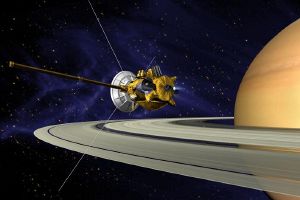
- Earth Orbit
- Automated Transfer Vehicle (ATV) - unmanned European cargo spacecraft
- Buran Soviet shuttle (one mission only)
- Explorer 1 - first US satellite
- Progress - unmanned USSR/Russia cargo spacecraft
- Project SCORE - first communications satellite
- SOHO
- Sputnik 1 - world's first artificial satellite
- Sputnik 2 - first animal in orbit (Laika)
- Sputnik 5 - first capsule recovered from orbit (Vostok precursor) - animals survived
- STEREO - Earth environment observation
- Syncom - first geosynchronous communications satellite
- Lunar
- Clementine - US Navy mission, orbited Moon, detected hydrogen at the poles
- Luna 1 - first lunar flyby
- Luna 2 - first lunar impact
- Luna 3 - first images of lunar far side
- Luna 9 - first soft landing on the Moon
- Luna 10 - first lunar orbiter
- Luna 16 - first unmanned lunar sample retrieval
- Lunar Orbiter - very successful series of lunar mapping spacecraft
- Lunar Prospector - confirmed detection of hydrogen at the lunar poles
- SMART-1 ESA - Lunar Impact
- Surveyor - first USA soft lander
- Surveyor - first Indian Lunar vessel
- Planetary
- Cassini-Huygens - first Saturn orbiter + Titan lander
- Galileo - first Jupiter orbiter+descent probe
- Mariner 4 - first Mars flyby, first close and high resolution images of Mars
- Mariner 9 - first Mars orbiter
- Mariner 10 - first Mercury flyby, first close up images
- Mars Exploration Rover - a Mars rover
- Mars Global Surveyor - a Mars orbiter
- MESSENGER - first Mercury orbiter (arrival 2011)
- Mars Pathfinder - a Mars lander + rover
- New Horizons - first Pluto flyby (arrival 2015)
- Pioneer 10 - first Jupiter flyby, first close up images
- Pioneer 11 - second Jupiter flyby + first Saturn flyby (first close up images of Saturn)
- Pioneer Venus - first Venus orbiter+landers
- Venera 4 - first soft landing on another planet (Venus)
- Viking 1 - first soft landing on Mars
- Voyager 2 - Jupiter flyby + Saturn flyby + first flybys/images of Neptune and Uranus
- Other - deep space
- Cluster
- Deep Space 1
- Deep Impact (space mission)
- Genesis
- Near Earth Asteroid Rendezvous
- Stardust
- WMAP
- Fastest spacecraft
- Helios I & II Solar Probes (252,792 km/h/157,078 mph)
- Furthest spacecraft from Earth
- Voyager 1 at 9.5824234 billion miles.
- Pioneer 10 at 8.3445237 billion miles.
- Voyager 2 at 7.4351695 billion miles.
- Heaviest spacecraft
- NASA STS Space Shuttle/Orbiter (109,000 kilograms/107 long tons/120 short tons)
Spacecraft under development
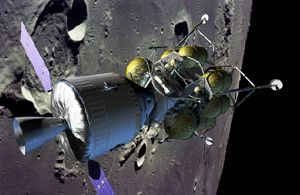
- Orion spacecraft
- Kliper - Russian ' Clipper '
- H-II Transfer Vehicle
- CNES Mars Netlander
- James Webb Space Telescope (delayed)
- Kepler Mission Planet Searcher
- ESA Darwin probe
- Herschel Space Observatory
- Mars Science Laboratory rover
- Shenzhou spacecraft Cargo
- Terrestrial Planet Finder probe
- X-37
- SpaceX Dragon manned spacecraft
- System F6 - a DARPA Fractionated Spacecraft demonstrator
- SSTO
- Reaction Engines Skylon and the earlier RR/British Aerospace HOTOL
- ESA Hopper Orbiter
- McDonnell Douglas DC-X (Delta Clipper)
- Roton Rotored-Hybrid
- Lockheed-Martin VentureStar
- NX-Alpha (Planning Stage)
See also
- Aircraft
- Astronaut
- Orbit
- Rocket
- Rocket propellant
- Satellite
- Space exploration
- Space Shuttle
- Space station
- Space tourism
- Yuri Gagarin
Notes
- ‚ÜĎ European Space Agency, "News," The Rosetta ground segment. ESA.int. Retrieved December 17, 2008.
ReferencesISBN links support NWE through referral fees
- Brown, Charles D. 2003. Elements of Spacecraft Design. Reston, VA: American Institute of Aeronautics and Astronautics, Inc. ISBN 1563475243.
- Fortescue, Peter, John Stark, and Graham Swinerd. 2003. Spacecraft Systems Engineering, 3rd Edition. New York, NY: J. Wiley. ISBN 0471619515.
- Sidi, Marcel J. 2000. Spacecraft Dynamics and Control: A Practical Engineering Approach. Cambridge, UK: Cambridge University Press. ISBN 0521787807.
- Wertz, James, and Wiley J. Larson. 1999. Space Mission Analysis and Design, 3rd ed. Torrance, CA: Microcosm. ISBN 9781881883104.
External links
All links retrieved February 7, 2023.
| ||||||||||||||||||||||||||||||||||||
Credits
New World Encyclopedia writers and editors rewrote and completed the Wikipedia article in accordance with New World Encyclopedia standards. This article abides by terms of the Creative Commons CC-by-sa 3.0 License (CC-by-sa), which may be used and disseminated with proper attribution. Credit is due under the terms of this license that can reference both the New World Encyclopedia contributors and the selfless volunteer contributors of the Wikimedia Foundation. To cite this article click here for a list of acceptable citing formats.The history of earlier contributions by wikipedians is accessible to researchers here:
The history of this article since it was imported to New World Encyclopedia:
Note: Some restrictions may apply to use of individual images which are separately licensed.
